Where to begin when buying a campervan or motorhome in UK?
We flew into United Kingdom, from Australia, to buy a campervan and tour Europe for three and a half months in 2017. We knew we wanted to hold onto our van for a number of years and return to chase the sun each year.
Did we research before flying in, yes. Hours and hours of internet trawling and forums.
Have we owned a campervan before, yes.
Did we know someone here, yes. To all of this, we say thank goodness.
We hope that our post will help others thinking of doing the same.
Of course there will be new terms, distances to consider
When you arrive in a new country, there are going to be differences. We are no stranger to travel, it is part an parcel of the experience.
Like when you buy a vehicle at home, it would of been great to find one ‘just down the road’. In another country you have to rely on public transport or factor in the cost of hiring a rental car.
In our case counting on a close friend (basically family) to drive us around. What felt like, from one side of England to the other. We were extremely thankful to have her drive us to view vehicles and her brother to provide invaluable knowledge on how the UK process works.
We will share these with you throughout this post.
Deciding what sort of vehicle will be suitable
From the beginning, we were thinking a campervan or small motorhome (no bigger than 18ft) for the following reasons;
- There are only 3 of us
- We have a motorhome in Australia and knew we did not need anything too big
- Cheaper, or so we thought
- Easier to manoeuvre on narrow roads in Europe and United Kingdom
- Allows easy parking in shopping centres for groceries
- Easier to willd camp/free camp
- Cheaper fuel costs
- Cheaper Insurance
- Budget 8,000 pounds
When we began researching vehicles and what would suit our needs, both campervan and small motorhome were in our budget. A motorhome would have provided a bit more room and we thought for resale, a wider audience.
Must haves included, Diesel, sleep 3, 3 seatbelts (seems obvious), Leisure Battery (2nd battery for 12V) No rust, Reasonable mileage for year of vehicle, Toilet (shower bonus but not necessary).
Sites to find vehicles
The sites we were using to find a vehicle were Ebay UK, Gumtree and Autotrader. If you knew the actual vehicle you wanted, then I would recommend joining and reading a forum for the make of car. Utilizing years of experience of others can save a lot of time. Also, facebook groups like Motorhome Adventures and Self Build Campervans are worth joining and sharing ideas.
Once we picked our vehicle type we read up on common problems and things to avoid on the forum. Also googled the car make and model, read articles, specifications, years of manufacture and reviews.
Roadworthy (MOT) Inspections and reports available online
In the UK all vehicles have to undertake an annual inspection (roadworthy) called a MOT (short for Ministry of Transport). When looking at vehicles online or in person, you are able to access the history of the vehicle. You can view it’s annual inspections online using its number plate.
This resource is INVALUABLE. It ensures you are aware of what has happened in the past. It will show if it has been fixed (if a fail is recorded the issues have to be fixed, if it is just a notification, this does not have to be addressed straight away).
Once you are the owner of a vehicle in the UK, every year you must have a MOT inspection done on the vehicle (roadworthy). This is recommended to be done one month prior to its expiry. These inspections on average cost 35 pound at the time of writing.
Every vehicle we inspected we had first searched on this database. This meant we had an idea of previous problems, prior to physically inspecting the vehicle.
Common problems may include, corrosion and rust (mainly due to salt on roads in winter), oil leaks and exhaust issues. They may be as simple as wipers not clearing screen adequately or headlight beam requires alteration.
Insurance
Insurance of any vehicle is important. We had discussed many different options with facebook groups prior to leaving Australia, for insuring a vehicle in the UK. It was a lot more complicated and restrictive and expensive, than we thought it would be.
Prior to purchasing our vehicle we rang for quotes from a minimum of 6 companies. Due to the age of vehicle and Australian nationality, only ONE would cover us.
Some of the conditions were, you must be a UK resident and the driver of the vehicle. Vehicle must be under 20 years old (Down Under Insurance, a popular choice for Australians). Must only be used in other areas of Europe for short trips (ie. Four weeks in duration) and return home to a UK residence.
They were all expensive and can offer 6 month or 12 month insurance periods. The six month option is of course at a premium. But why cover the vehicle for a period that you will not use if touring for only part of the year. In most cases there is no refund available for cancellation of a policy. Everyone will travel for different periods and have different needs. Ask questions.
Exclusions
There are exclusions of certain countries by all insurers – make sure you are covered in the countries you intend to visit. The insurer we selected (only option available), will cover third party in excluded countries if notified prior and a further premium will apply for the time there. It can be possible in some countries to buy a third party cover at the border.
Be aware any amendment to the policy, once it is put in place, generally incurs a fee. For example adding a driver, so get your facts and requirements right first time. Eg. Amendment or alteration is 25 pound with our insurer MS Emblem through the broker HIC (Herts Insurance). The next year we returned they found a different insurer, but we used the same broker.
Once the policy is put in place, they send you a green card insurance confirmation document that must remain with the vehicle.
Breakdown Roadside Assistance
Options available include RAC, AA, Brittania Rescue and some insurers include it as part of their insurance policies for a small fee. But ours does not cover tourist policies for breakdown. Ridiculous, we have just as much chance of breaking down as the next person, but anyway.
On forums and the like, they mention a simple tow can incur a cost of around 150 pound each time. This will depend where you are of course. Up to you, if you determine it is worth approximately 300 pound for roadside assistance and peace of mind.
Registration of your vehicle
When you purchase the vehicle you shall be given a V5 registration
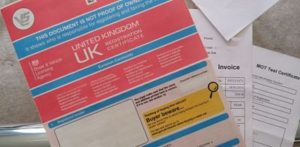
document and if bought from a dealer receipt for purchase. (We also photographed the sellers papers they will submit to the Department as a precaution).
You can access the Driver and Vehicle Licensing Centre online. Confirm purchase or sale of a vehicle and will be sent your new V5 document showing you as the registered keeper (owner) in due course. Take this with you. It can take a couple of weeks to arrive.
If you are keeping the vehicle, when you finish your roadtrip but storing it. Taking it off the road (ie. When we return home to Australia and the vehicle will not be in use till we return next year) you are able to ‘SORN’ the vehicle. Which freezes the registration. This will NOT freeze the requirement for MOT inspections and you still must ensure this is done.
Registration can be paid monthly by direct debit. If your insurance expires (ie. you only took out 6 month policy) you must SORN the vehicle.
Manual or Automatic
There are a LOT of manual vehicles and you will be restricted if you are only looking to purchase an automatic. You will definitely need to budget a little more if you require Automatic transmission only. This is what we found researching motorhomes and campervans approximately 20 years old.
We have found the manual gearbox an absolute must when driving in mountainous terrain, which we love.
Let the inspections begin…….
Vehicle No. 1 (3 hours return trip)
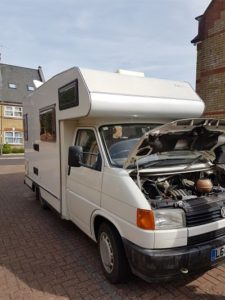
A small 18ft motorhome, a 1993 Volkswagon Valentine Manual with above cabin 2 berth plus another 2 by utilising dinette. Before leaving, we negotiated an acceptable price for the vehicle conditional on inspection to avoid wasting our friends time and fuel costs.
On arrival when trying to start the vehicle, the battery was flat. Her response, maybe because we turned on a 12v light in the cabin we flattened it. On inspection of the oil, we found it to be black as black.
We questioned her later and asked if she had done a service or oil change recently, which she said yes it was done. Lie No. 2. No knowledge of any switch, button or appliance in the vehicle had warning bells sounding.
It was as though she never owned the vehicle, let alone travelled in it. After some time inspecting the vehicle (and finding jumper leads from a neighbour) we got it going. Who doesn’t want the first one they inspect to be ‘THE ONE’. But, we found oil leaking from the bottom of the sump, read over receipts they had. The ‘new’ battery was actually 2015, fuel and temperature gauge suddenly stopped ‘gauging’.
In addition to these items and too many evasive responses, it led us to walk away (very fast) and put that one down to a learning experience.
Vehicle No. 2 (3 hours return – different direction, north this time)
Before leaving we had a list of questions that would ensure this would be ‘THE ONE’ and no more time wasting. We were viewing an 18ft, 4 Berth, Diesel Motorhome, and we asked what we thought was all the right questions before setting off.
On arriving, it looked great, reasonable condition, the lovely elderly couple had looked after it. Excitement grew.
Looking through the motorhome, ticking off all the boxes, we were thinking this is it. We had one more question. Where is the seatbelts in the rear cabin? No, there are no seatbelts and they can’t be fitted. Aaarrgghh. We still don’t quite understand how you can have a four berth motorhome with only two seatbelts fitted!
Frustrated and wanting to let off some steam we went to the pub! Over a beer and cider we checked what else was around in the area.
This brings us to….
Inspection No. 3 (20 minutes from last inspection, through THE most beautiful country lanes)
What a joy to inspect, because the drive there was lovely. The landscape, the properties, the country roads, everything green and beautiful. The Sun was shining, the sky was blue and ‘This would be THE ONE’.
It was a little more than we had wanted to spend. After spending HOURS and HOURS on Ebay, Gumtree, Autotrader and the Motor Transport Department checking the vehicles annual inspections. We were thinking maybe we have to consider something a bit more than our original budget.
We met the most lovely retired couple who showed us around their 20ft Fiat Ducato Diesel 4 Berth Motorhome – WITH four seatbelts. But the length was just too long for what we needed (it would not fit in a standard car park) so alas off we went home.
Inspection No. 4 (3 hours return, sensing a pattern here…)
1991 Talbot Express 18ft Motorhome 5 Berth. All Questions asked before going, MOT check done – fantastic.
On arrival, the owner who just got back from a 5 day festival had not ‘realised’ he had backed into ‘something’. It had breached the top edge at the rear and further damage along the side that would need immediate attention. But “it’s not a big problem, I can give you the fibreglass to fix it” hmmmm.
We also were not happy with the seatbelt in the back where Miss B would sit.
We ended up visiting my friends brother who was staying at their cabin nearby and had a wonderful night full of laughter and maybe a drink or three.
By this time we had come to the conclusion, we were definitely only interested in a campervan. There was limited, in our opinion, choices that had a suitable layout, utilised the space well and provided just enough comfort with practicality.
Unfortunately the price for these are normally a bit more expensive and more sought after which will help with resale in the future. Particularly those with minimal or no rust and outstanding corrosion issues.
Vehicle No. 5 (5 hours return trip) – ‘THE ONE!’
Off we went to Southampton and to our first dealer who had said he had two to look at. Although one I had already seen online, checked its MOT and was certain it would be …..’THE ONE’.
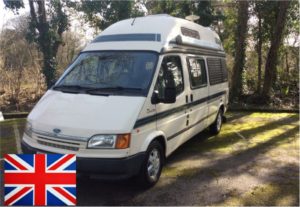
It was a 1995 Ford Transit Duetto Diesel 2 Berth Campervan.
Negotiated before we got there, a suitable purchase price subject to inspection. The vehicle presented as it was photographed and being a hightop meant a much more comfortable living area for hubby, being over 6’.
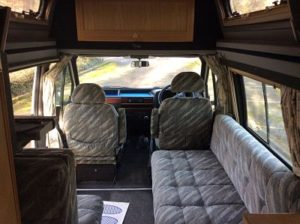
Using the benchseat bed and the single bed they cover the full width of the campervan. Easily suitable for 3 people to sleep comfortably. The flexibility of two table options, allowing one person to lie down while the smaller table is still in use, is perfect for our small family.
Being Diesel, it is less to run than a petrol engine and lasts a lot longer. Very important when looking at an older vehicle.
It was in immaculate condition. Even taking into consideration that most
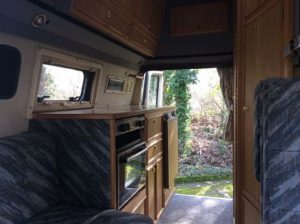
people in the UK only use them for the summer months of the year. So they will get a lot less use than in Australia. Pleased to say that the Oven, Grill and cooktop all work perfectly.
Passenger seat is a captains chair which means it rotates 180 degrees to face rear cabin. This is a good asset.
We have what is called a safari room, which is essentially a tent that attaches to the side of the van. Providing an extra room, when long term travelling. We shall not be taking this with us, as we will be on the move constantly.
All windows in cabin have both flyscreens and full blockout curtains that retract into window frame. A great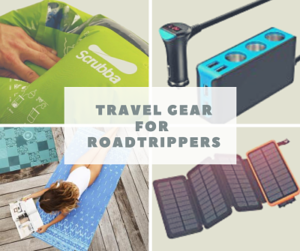 addition for privacy and sun.
addition for privacy and sun.
We will provide a followup post of changes we made to it and items we purchased before taking off.
Like all vehicles you can research, check over them and sometimes you get a good one and other times you get a lemon. Only time will tell.
We are more than happy with our choice and we will have it serviced prior to taking off to ensure we start on the right foot…or tyre as the case may be!
For a full video tour of our vehicle Click here.
Notes that may help you
- Always check MOT before physically inspecting vehicle (do not buy one without a MOT)
- Take a magnet with you to identify rust covered up with paint or tar (under vehicle)
- A service history is a plus
- If the number plate is not visible in photos on line (especially a dealer) be wary
- Diesel engines only start wearing in at 100,000KM or 50,000 Miles (UK vehicles are in Miles)
- People try to cover up rust or corrosion with black tar like substance under vehicles
- Check toilette cassette is in its locker
- Don’t assume there are seatbelts in cabin
- Insurance is expensive allow at least $2000 Australian a year (1000 pound) and this is for a vehicle under 10,000 pounds
We hope this post helps you if your considering buying a campervan or motorhome in the UK! There is heaps of helpful posts on our blog about wildcamping, Apps and Maps and LOTS of youtube videos of our adventures around Europe.


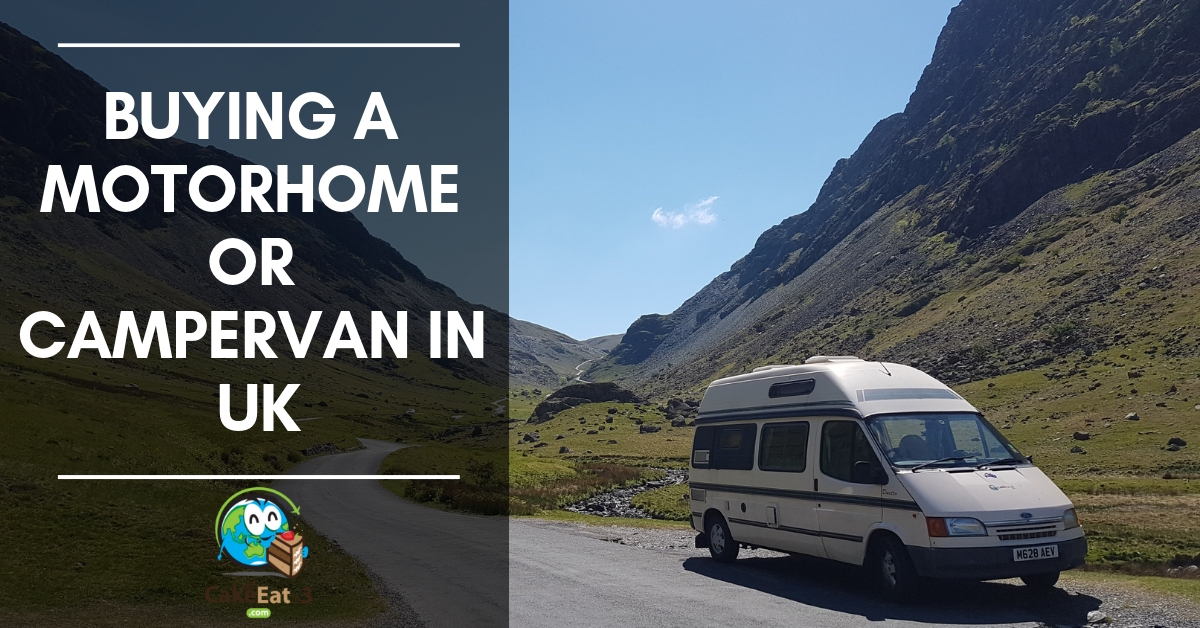
[…] Buying a Campervan or Motorhome in UK […]
[…] Buying a Campervan or Motorhome in UK […]
[…] Buying a Campervan or Motorhome in UK […]
[…] Buying a Campervan or Motorhome in UK […]